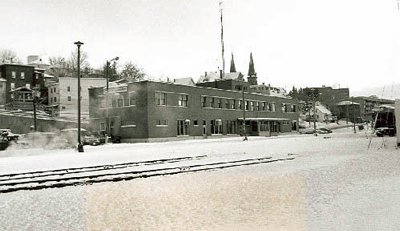Canadian National Railways Station
Heritage Railway Station of Canada
Edmundston, New Brunswick

General view
© Parks Canada Agency / Agence Parcs Canada, S. D. Bronson, 1996.
Address :
194 Saint François Street, Edmundston, New Brunswick
Recognition Statute:
Heritage Railway Stations Protection Act (R.S.C., 1985, c. 52 (4th Supp.))
Designation Date:
1996-06-01
Dates:
-
1959 to 1959
(Construction)
-
1959 to 1989
(Significant)
Event, Person, Organization:
-
Canadian National Railways
(Organization)
Other Name(s):
-
Edmundston Railway Station
(Other Name)
Research Report Number:
RS-284
Description of Historic Place
The Canadian National Railways (CNR) Station at Edmundston is located on Saint-Francois Street, on a large site that extends from downtown Edmundston to the Saint John River in New Brunswick. Constructed in 1959, the station is a rectangular two-storey brick building with a three-storey central tower whose sleek lines and volumes reflect International style construction principles. The formal recognition is confined to the railway station building itself.
Heritage Value
The Canadian National Railways Station at Edmundston was designated a heritage railway station for its historic, architectural and environmental importance.
The CNR Station at Edmundston was built in 1959 as a leading edge company initiative focusing on Maritime service, despite falling railway revenues. This station was to act as the traffic hub of the new service. Its construction was evidence of the CNR’s restrained survival strategy and its confidence in the future of the Atlantic region. As such, the erection of this station represented a significant event in the railway history of the Maritimes.
A fine example of the International Style, this station is one of the last and most successful of the buildings constructed by the CNR in the twenty year period following the Second World War. With its low-lying, rectangular form assembled as brick horizontal volumes with an asymmetrical tower, and its linear orientation emphasized by the lines of the canopy and contrasting inset windows, the station is an exceptional example of high-quality construction. The site of the station, covering a large expanse of land between the Saint John River and the urban area of Edmundston, retains much of its early character.
The heritage value of the CNR station at Edmundston resides in the quality of its construction, its spare interpretation of the modern style, its intact interior elements and finishes, and its location.
Sources: Heritage Character Statement, Canadian National Railways Station, Edmundston N.B., August 1996. Heritage Assessment Report RSR-284, 1995.
Character-Defining Elements
Character-defining elements of the CNR Station at Edmundston include: its rectangular footprint two-and-a-half storey massing and footprint; cut asymmetrically by a flat-roofed, slightly projecting central three storey tower; its substantial, geometric volumes; its strong, simple, clean lines; its asymmetrical composition; the horizontal orientation of the body of the building; the vertical orientation of the tower; the rhythmic placement of windows in inset bands, both horizontally on the body of the building and vertically on the tower; its reflection of International style principles in the smooth, minimalist detailing, linear canopy, regularly sized rectangular windows deployed in groups of one, two or three with tops aligned, the use of a tower to create contrasting line and volume, the use of a concrete feature line between storeys and to outline window insets; the contrasting colours and smooth, supple textures of its original materials: smooth brick on concrete block walls, large uniform glass window surfaces, three panel wooden and glass doors, smooth concrete faced window indent, tar and gravel roof, and iron canopy; any and all original fabric inside the station and in particular evidence of its hierarchical use to reflect the public and/or utilitarian role of specific space; the use of contrasting thin paving stones and a low, long window box to provide embellishment or decoration to the tower; the deployment of smoothly finished high quality materials in the public areas, particularly pale yellow glazed tiles, simple chrome trimmed ramps, terrazzo floors, plaster surfaces, suspended ceilings, light fixtures; the building’s horizontal functional plan activated by an elevator in the tower; the legibility of its rational functional layout with public spaces on the ground floor, administrative and technical spaces above, and service spaces in the basement; the practicality of its functional layout with the third floor of the tower housing a mechanical room and vestibule to access the roof; the legibility of its original interior spatial volumes; the maximization of natural light on the interior of the building, particularly as accomplished by the original placement and configuration of windows; the continuity of longstanding circulation patterns; the overall integrity of the building’s form, plan, material, and detail; its relationship with the tracks and with the simple, utilitarian character of the site.